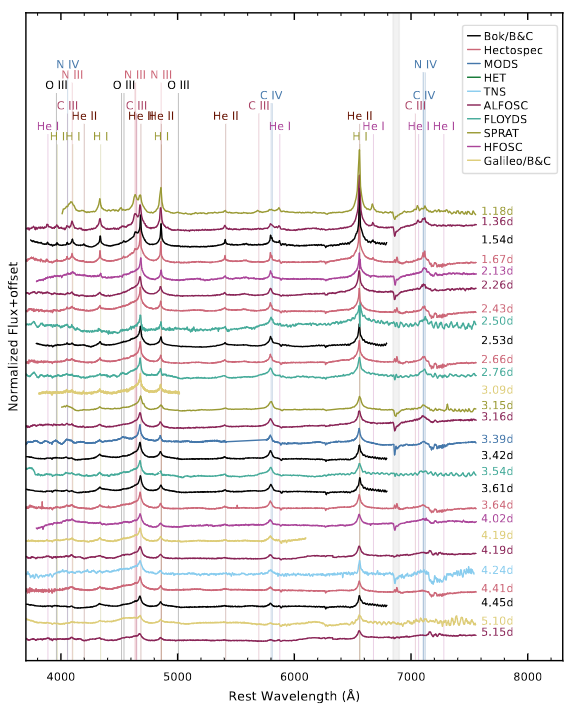Early Spectroscopy and Dense Circumstellar Medium Interaction in SN 2023ixf
K. Azalee Bostroem, Jeniveve Pearson, Manisha Shrestha, David J. Sand, Stefano Valenti, Saurabh W. Jha, Jennifer E. Andrews, Nathan Smith, Giacomo Terreran, Elizabeth Green, Yize Dong, Michael Lundquist, Joshua Haislip, Emily T. Hoang, Griffin Hosseinzadeh, Daryl Janzen, Jacob E. Jencson, Vladimir Kouprianov, Emmy Paraskeva, Nicolas E. Meza Retamal, Daniel E. Reichart, Iair Arcavi, Alceste Z. Bonanos, Michael W. Coughlin, Joseph Farah, Suzanne Hawley, Leslie Hebb, Daichi Hiramatsu, D. Andrew Howell, Takashi Iijima, Ilya Ilyin, Curtis McCully, Sean Moran, Brett M. Morris, Alessandra C. Mura, Megan Newsome, Maria Th. Pabst, Paolo Ochner, Estefania Padilla Gonzalez, Andrea Pastorello, Craig Pellegrino, Aravind P. Ravi, Andrea Reguitti, Laura Salo, Jozsef Vinko, J. C. Wheeler, G. Grant Williams, Samuel Wyatt
We present the optical spectroscopic evolution of SN 2023ixf seen in subnight cadence spectra from 1.18 to 15 days after explosion. We identify high-ionization emission features, signatures of interaction with material surrounding the progenitor star, that fade over the first 7 days, with rapid evolution between spectra observed within the same night. We compare the emission lines present and their relative strength to those of other supernovae with early interaction, finding a close match to SN 2020pni and SN 2017ahn in the first spectrum and SN 2014G at later epochs. To physically interpret our observations, we compare them to CMFGEN models with confined, dense circumstellar material around a red supergiant (RSG) progenitor from the literature. We find that very few models reproduce the blended N III (λλ4634.0,4640.6)/C III (λλ4647.5,4650.0) emission lines observed in the first few spectra and their rapid disappearance thereafter, making this a unique diagnostic. From the best models, we find a mass-loss rate of 10-3-10-2 M ⊙ yr-1, which far exceeds the mass-loss rate for any steady wind, especially for an RSG in the initial mass range of the detected progenitor. These mass-loss rates are, however, similar to rates inferred for other supernovae with early circumstellar interaction. Using the phase when the narrow emission features disappear, we calculate an outer dense radius of circumstellar material RCSM,out ≈ 5 × 1014 cm, and a mean circumstellar material density of ρ = 5.6 × 10-14 g cm-3. This is consistent with the lower limit on the outer radius of the circumstellar material we calculate from the peak Hα emission flux, RCSM,out ≳ 9 × 1013 cm.

NASA/ADS: 2023ApJ…956L…5B
